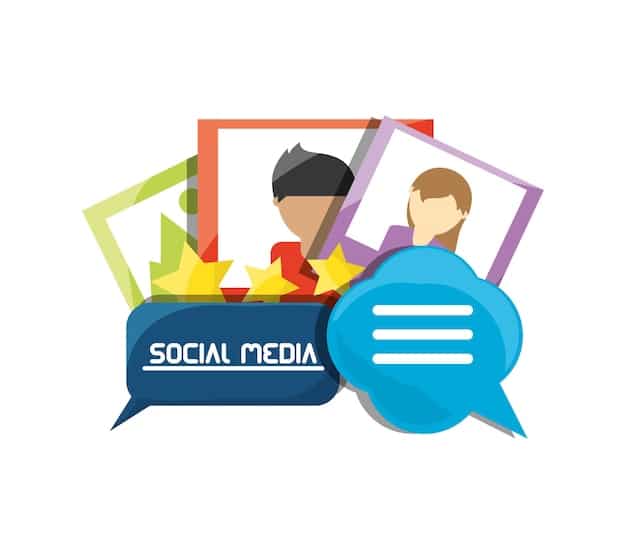Social Media on a Budget: $500 Growth Plan for US Small Businesses

Social media for small businesses in the US doesn’t have to break the bank; this article outlines how to strategically leverage a $500 budget to build brand awareness, engage customers, and drive growth using various social media platforms and tactics.
Are you a small business owner in the US looking to boost your brand presence without emptying your wallet? Navigating the world of social media for small businesses can seem daunting, especially when budget constraints are a concern. But don’t worry! It’s entirely possible to create a strong social media presence and drive growth with a strategic approach, even on a limited budget of $500.
Unlocking Social Media Success: A $500 Blueprint
Many small business owners think you need thousands of dollars to have an impact on social media, but this is a misconception. There are numerous ways to achieve real growth by focusing on the right strategies and tools, even with a limited budget. Let’s dive into a step-by-step guide to maximize your impact with a $500 social media budget.
Understanding Your Target Audience
Before you spend a single dollar, you need to know exactly who you’re trying to reach. Knowing your target audience will allows you to save time and money by focusing your efforts on the platforms where they are most active.
What are their demographics? What are their interests? What problems do they have that your business can solve? Answer these questions to create detailed buyer personas. Use free tools like Google Analytics to gather data on your website visitors, and conduct surveys or polls on social media to gain direct insights from your audience.
Choosing the Right Platforms
Not all social media platforms are created equal, and not all platforms are right for your business. It’s better to focus your efforts on one or two platforms where your target audience is most active and where you can create engaging content.
- Facebook: Still the largest social media platform, ideal for reaching a broad audience.
- Instagram: Great for visual content and reaching a younger demographic.
- Twitter: Best for real-time updates, news, and engaging in conversations.
- LinkedIn: Ideal for B2B businesses and professional networking.
By carefully selecting the right platforms, you will be able to maximize your efforts and reach the people who are most likely to become your customers.
Once you understand your target demographic and the platforms that they frequent, you can effectively spend the funds you have allocated for your social media advertising budget.
Crafting Compelling Content on a Budget
Content is the cornerstone of any successful social media strategy. It’s how you attract and engage your audience, build brand awareness, and ultimately drive conversions. But creating high-quality content doesn’t have to be expensive. Focus on delivering value.

Content Pillars: Your Content Foundation
Determine 3-5 key themes or topics that resonate with your target audience and align with your brand values. These content pillars will serve as the foundation for your content strategy, ensuring consistency and relevance.
For example, if you own a bakery, your content pillars could be:
- Baking tips and recipes
- Behind-the-scenes glimpses of your bakery
- Customer testimonials and reviews
- Local community events and promotions
By developing content pillars you can be sure to have relevant and strategic content going out to your target audience. Also, it helps save time by giving you a foundation.
Leveraging User-Generated Content
One of the most cost-effective ways to create content is by leveraging user-generated content (UGC). Encourage your customers to share their experiences with your product or service on social media and offer incentives like discounts or features on your page.
UGC not only provides authentic and engaging content, but it also builds trust and social proof with your audience.
Remember to always ask for permission before sharing UGC and credit the original creator.
Creating truly unique and engaging content is essential to standing out in a large crowd.
Strategic Ad Campaigns with $500
While organic reach is important, paid advertising can significantly amplify your social media efforts and reach a wider audience. With a $500 budget, you can run targeted ad campaigns on platforms like Facebook and Instagram to achieve specific goals.
Defining Your Campaign Goals
Before launching any ad campaign, it’s crucial to define your goals. Do you want to increase brand awareness, drive website traffic, generate leads, or boost sales? Once you have clear goals, you can tailor your ad campaigns to achieve them.
- Brand Awareness: Reach a broad audience and increase brand visibility.
- Website Traffic: Drive more visitors to your website.
- Lead Generation: Collect contact information from potential customers.
- Sales Conversions: Directly drive sales through targeted ads.
Understanding your goals for the ad dollars, will help you make the necessary decisions when it comes to the content of your ads.
Paid advertising effectively gets the word out, but ensuring the message is valuable and engaging is up to the content creators.
Targeted Advertising
Social media platforms offer robust targeting options that allow you to reach specific demographics, interests, and behaviors. Take advantage of these targeting options to ensure that your ads are seen by the people who are most likely to be interested in your product or service.
For example, if you’re running a campaign to promote a new product, you could target people who have shown interest in similar products or who follow your competitors.
Targeting is the most important aspect of a succesful advertising campaign. Don’t waste time and money advertising to those who are not interested.
Engaging with Your Community
Social media is all about building relationships and fostering a sense of community. It’s not enough to just post content; you need to actively engage with your audience and respond to their comments, questions, and concerns. One of the best things you can do is offer a free valueable item.

The Power of the Engagement
When customers comment on your posts, send you messages, or mention your brand, respond promptly and professionally. Show them that you value their input and are committed to providing excellent customer service.
- Respond to comments and messages within 24 hours.
- Address customer complaints and concerns with empathy and understanding.
- Offer solutions and compensation when appropriate.
It’s so important to respond and make sure the customers know you are listening. This will increase your reputation and overall brand image.
Customers are always looking for reasons to work with someone they can trust. This is a very small and straightforward way to do so.
Running Contests and Giveaways
One of the most popular and effective ways to boost engagement on social media is by running contests and giveaways. These events generate excitement, increase brand awareness, and encourage participation from your audience.
Offer prizes that are relevant to your business and appeal to your target audience. For example, you could give away a free product, a gift card, or a VIP experience.
Social media contests can also be a great way to grow your email list or drive traffic to your website.
The key is finding the sweet spot where people are excited but also ready to act quickly. Many studies have found the shorter the contest time, the better.
Tracking Your Results
The great thing about social media is nearly every action can be tracked! Tracking your results is essential for understanding what’s working and what’s not. By monitoring key metrics, you can optimize your social media strategy. Use these tools to keep an eye on essential metrics that will show the effectiveness of the content.
Tools
There are many reporting metrics that you can track to understand if your content is resonating with your target audience. To begin to capture the data, you’ll need to utilize some of the amazing tools available to you. Many of which are free.
- Google Analytics: Tracks website traffic and user behavior.
- Social Media Analytics Tools: Facebook Insights, Instagram Insights, Twitter Analytics.
With the right tools you can easily view data on your social media progress. As the saying goes, you can’t improve if you don’t measure!
Remember to view the data collected in weekly increments. This will allow you to assess changes quicker and avoid investing in poorly performing content.
Measuring Key Metrics
Track key metrics like reach, engagement, website traffic, and conversions to measure the success of your social media efforts. Analyze the data to identify trends, patterns, and areas for improvement.
- Reach: The number of people who have seen your content.
- Engagement: The number of likes, comments, shares, and clicks your content has received.
- Website Traffic: The number of visitors driven to your website from social media.
- Conversions: The number of leads or sales generated from social media.
When you have a good understanding of these reporting metrics, you can make data driven decisions to ensure you’re always improving.
With social media, you shouldn’t be guessing. Use data to your advantage and quickly rule out actions that are not providing a sufficient ROI.
Optimizing Your Strategy for Long-Term Growth
Social media is not a sprint; it’s a marathon. Building a strong social media presence takes time, effort, and consistency. It’s important to continuously optimize your strategy based on the results you’re seeing and adapt to the ever-changing social media landscape.
Staying Up-to-Date
Social media platforms are constantly evolving, with new features, algorithms, and trends emerging all the time. Stay up-to-date on the latest changes and adapt your strategy accordingly. Follow industry blogs, attend webinars, and engage with other social media professionals to stay ahead of the curve.
- Read posts written by social media experts.
- Subscribe to newsletters that can help keep you updated.
- Pay attention to the content of companies that perform well.
Being at the forefront of the trends can lead to significantly better results on social media.
When planning your social media content, make sure you are considering all relevant holidays and milestones.
Testing and Experimenting
Don’t be afraid to test new ideas and experiment with different content formats, targeting options, and advertising strategies. The social media marketing world is always changing, so you must not be afraid to make the changes with it.
- Run A/B tests to compare different ad creatives or targeting options.
- Try new content formats like live video, stories, or reels.
- Experiment with different posting schedules and frequencies.
Don’t be afraid to take educated chances and try something new!
Success comes from constant improvement! Those who settle for ‘good enough’ are usually left behind.
| Key Point | Brief Description |
|---|---|
| 🎯 Target Audience | Identify your ideal customer to refine social media efforts. |
| 📱 Platform Selection | Choose the platforms that align with your small business and target audience. |
| 💰 Budgeting | Allocate a specific budget (e.g., $500) to advertising campaigns. |
| 📊 Analytics | Track and analyze key metrics to refine your small business content. |
FAQ
▼
Yes, a strategic approach to content, community, and analytics can expand your sphere of influence without breaking the bank.
▼
It depends on your target audience and industry, but Facebook, Instagram, Twitter, and LinkedIn are great spots to begin.
▼
You must know the data. Track metrics like reach, engagement, website traffic, and conversions to check the effectiveness.
▼
The posting schedule depends on the platform. Check the analytics and see when the ideal time is for posting.
▼
Clear copy, valueable offer, a highly targeted audience, and a strong call-to-action is the key to success. Good luck!
Conclusion
With a well-defined target audience, compelling content, and a strategic approach, you can achieve substantial growth on social media for small businesses with a carefully planned budget of $500. By focusing on engagement, analyzing your results, and staying adaptable, you can continuously optimize your strategy and build a thriving online presence in the US market.





